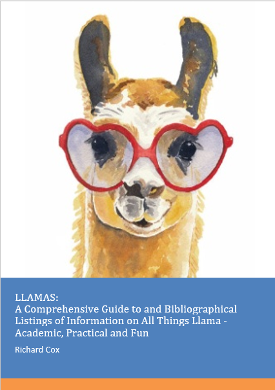For overview and introductory pages of individual volumes click on the images above. For overview of the series, as a whole, read below.
During the course of researching and writing this set of books on the llama I often wondered why I was doing it, especially when there were so many other things to get on with and sometimes, it was the end of the day and I was tired. Having now completed them, I am perhaps in a better position to more accurately reflect back on why and I think it is true to say that the impetus for this book was fourfold.
Firstly, there were things about the llama I personally wanted to know more about, some of which existing literature had the answers to but also an awful lot of questions that required original research.
Secondly, I have always found it helpful to write about subjects of interest to me to better understand them and retain in my head, long-term. For me, it is a cathartic exercise that enables me to assemble my knowledge and understanding into some, at least for me, coherent order on which I can draw on from time to time and if appropriate, share with others. Bringing it all together in the one or series of book provides a ready reference source that can be tapped into and save much time when required. I recommend it to anyone who has not already tried or simply has a burning ambition to share some of their thoughts and experiences. However, I am the first to admit I am not an ‘animal professional’ as a farmer or vet, just passionate about animals. My professional training is in, and my previous writings about, sports science. llama breeding is a post-retirement reinvention of myself.
Thirdly, as a born educationist, I am driven to point other interested parties, be they ‘animal professionals’, hobbyists, or simply interested members of the general public, to the vast and useful knowledge and information that already exists, including that which is available elsewhere, including on the World Wide Web. This is the main purpose of volume 3. Unfortunately, there are individuals who seem to think that one book or the results of a single search using Google will find them everything there is to usefully know about llamas. This is far from the truth.
Like on any subject matter, knowledge is not definitive and explanations about most things are open to different interpretations and likely to change over time as more experience and better means of investigating issues become available to researchers. All we can do for the moment is access as much reliable evidence as we can get hold of, listen to what others have had to say and interpret it all as honestly and informed as we can. Few theories and models of explanation stand the test of time and I am sufficiently modest to admit this will be true of much of what I have to say here. However, my plan is that I will update and modify the book as and when I discover anything new that adds to the discussion or changes my interpretation of events. This is another advantage of it being a live publication readily accessible on the internet.
Fourthly, and perhaps more pretentiously, to help combat the spread of what I had come to realise were many naive, ill-informed, inaccurate or simply misleading statements made about llamas by individuals, especially via social networking sites. Whilst the internet has provided us with numerous benefits, a downside is that it has effectively allowed mass publishing without any scrutiny, peer review or other form of quality control and promoting, in some cases, poor practice amongst non-discerning readers. Often, in the absence of evidenced research, accessible expert authority, written guidance, such advice was ill conceived, albeit expressed with good intention but sometimes based on nothing more than conjecture, llama folklore, hunches, best guesses, limited experience or inadequate training. Occasionally, it was expressed for convenience, to support personal practice, questionable motives, values and views or those of friends. At its very worst, there is a danger it was purposeful misinformation, spin or fake news.
In an effort to avoid acting in a similar vein, I have invited many individuals to read and comment on earlier drafts and as I mention in my acknowledgements benefitted greatly from their corrections and suggestions. As and when further information comes to light additions and changes will be accommodated which as noted in my Introduction will be easily facilitated as an on-line live publication.
Several researchers, mentioned throughout these monographs have kindly helped better our understanding of the history, health, husbandry and welfare of llamas. The intention here is that this series of books brings together in one place their findings on specific subject areas with those of other areas of interest and compliments these with finding from my own original research on subjects hitherto unexplored. In so doing, it is also hoped the more obscurely reported research, in for example academic journals, will reach wider audiences. My aspiration is that the knowledge will be found by the reader to be well organised and expressed in such a fashion as to be interesting, comprehendible, easily digestible and in the case of volume 3, meaningfully applicable. That is for all those with an interest in llamas, no matter what their connection, but especially those who can benefit from knowing and is so doing enhance the understanding, profile and care of these wonderful animals.



